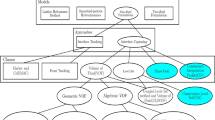Abstract
The fluid temperature statistics along particle trajectories is crucial to understand the mechanisms of turbulent non-isothermal or reactive fluid-particle flow, especially for the Lagrangian model of non-isothermal particle-laden turbulent flow. In the present study, direct numerical simulations were utilized to generate temperature field statistics in particle-laden incompressible stationary homogeneous isotropic turbulent flows, which is focused on the effect of particle response time on the Lagrangian statistics of the particle and the fluid temperature seen by particles. It shows that, for the particles with τ p/τ k < 1, the ratio of the fluid intensity seen by particle to fluid temperature intensities deceased as τ p/τ k increased; while for larger particles (τ p/τ k > 1), the trend is inversed. For small particles (τ p/τ k<5), the Lagrangian autocorrelation coefficient of the particle temperature R p T decreases as the particle inertia (τ p/τ k) increases. The trend is reversed for larger particles. The autocorrelation of fluid temperature along the particle path, R pf T, decreased as the particle inertia increased. And as the particle inertia increased, the autocorrelation coefficient of the fluid temperature seen by particle decreased more rapidly than that of the particle temperature. The mean temperature gradient contributes to the correlation between the particles velocity component and temperature fluctuations in the direction of the gradient. For the particles with τ p/τ k<1, the magnitude of the correlation coefficient increases as the particle inertia increases, while this value is independent of the particle time constant for larger particles.
Similar content being viewed by others
References
Batcherlor, G. K., Diffusion in a field of homogeneous turbulence. II: The relative motion of particles, Proc. Camb. Phil. Soc., 1952, 48: 345–362.
Elghobashi, S., Truesdell, G. C., Direct numerical simulation of particle dispersion in a decaying isotropic turbulence, J. Fluid Mech., 1992, 242: 655–700.
Squires, K. D., Eaton, J. K., Measurements of particle dispersion obtained from direct numerical simulations of isotropic turbulence, J. Fluid Mech., 1991, 226: 1–35.
Berlemont, A., Desjonqueres, P., Gouesbet, G., Particle lagrangian simulation in turbulent flows, Int. J. of Multiphase Flow, 1990, 16(1): 19–34.
Maxey, M. R., The gravitational settling of aerosol particles in homogeneous turbulence and random flow fields, J. Fluid Mech., 1987, 174: 441–465.
Riley, J. J., Patterson, G. S., Diffusion experiments with numerically integrated isotropic turbulence, Phys. Fluids, 1974, 17(2): 292–297.
Elghobashi, S., Abou-Arab, T. W., A two-equation turbulence model for two-phase flows, Phys. Fluids, 1983, 26(4): 931–938.
Boivin, M., Simonin, O., Squires, K. D., Direct numerical simulation of turbulence modulation by particles in isotropic turbulence, J. Fluid Mech., 1998, 375: 235–263.
Ferrante, A., Elghobashi, S., On the physical mechanisms of two-way coupling in particle-laden isotropic turbulence, Phys. Fluids, 2003, 15(2): 315–329.
Squires, K. D., Eaton, J. K., Particle response and turbulence modification in isotropic turbulence, Phys. Fluids, 1990, A 2(7): 1191–1203.
Sato, Y., Deutsch, E., Simonin, O., Direct numerical simulations of heat transfer by solid particles suspended in homogeneous isotropic turbulence, Int. J. Heat and Fluid Flow, 1998, 19(2): 187–192.
Jaberi, F. A., Temperature fluctuations in particle-laden homogeneous turbulent flows, Int. J. Heat Mass Transfer, 1998, 41(24): 4081–4093.
Jaberi, F. A., Mashayek, F., Temperature decays in two-phase turbulent flows, Int. J. Heat Mass Transfer, 2000, 43(6): 993–1005.
Canuto, C., Hussaini, M. Y., Quarteroni, A. et al., Spectral Methods in Fluid Dynamics, New York: Springer-Verlag, 1988.
Eswaran, V., Pope, S. B., An examination of forcing in direct numerical simulations of turbulence, Computers & Fluids, 1988, 16(3): 257–278.
Balachander, S., Maxey, M. R., Methods for evaluating fluid velocities in spectral simulations of turbulence, J. Comput. Phys., 1989, 83(1): 96–125.
Comte-Bellot, G., Corrsin, S., Simple Eulerian time correlation of full and narrow-band velocity signals in grid-generated isotropic turbulence, J. Comput. Phys., 1971, 48: 273–337.
He, Z., Liu, Z. H., Chen, S. et al., Particle behavior in isotropic turbulence, Acta Mech. Sinica, 2005, 21(2): 112–120.
Taylor, G. I., Diffusion by continuous movements, Proc. Lond. Math. Soc., 1921, 20: 196–212.
Csanady, G. T., Turbulent diffusion of heavy particles in the atmosphere, J. Atmos. Sci., 1963, 20: 201–208.
Author information
Authors and Affiliations
Corresponding author
Rights and permissions
About this article
Cite this article
He, Z., Liu, Z., Chen, S. et al. Effect of particle inertia on temperature statistics in particle-laden homogeneous isotropic turbulence. SCI CHINA SER E 49, 210–221 (2006). https://doi.org/10.1007/s11431-006-0210-7
Received:
Accepted:
Published:
Issue Date:
DOI: https://doi.org/10.1007/s11431-006-0210-7




